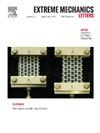Synergizing machine learning and multiscale shakedown method for shakedown loading capacity evaluation of parameterized lattice structures
IF 4.5
3区 工程技术
Q2 MATERIALS SCIENCE, MULTIDISCIPLINARY
引用次数: 0
Abstract
In recent years, advanced soft computing methodologies have emerged as more effective than traditional approaches in estimating fatigue properties. However, a significant research gap remains in efficiently and accurately evaluating the multiaxial loading capacities of lattice structures and the impact of mesoscale design parameters, especially under unknown cyclic conditions during operation. To address this, we propose a data-driven methodology that integrates a multiscale shakedown evaluation method with a hybrid machine learning (HML) model. Our HML model, incorporating ensemble learning techniques and hyperparameter tuning via random search, accurately predicts the multiaxial shakedown fatigue loading capacity of a representative peanut-shaped auxetic lattice structure with parameterized geometry. The HML model's exceptional performance, demonstrated by a Normalized Root Mean Squared Error (NRMSE) of 0.018 and a coefficient of determination (R2) of 0.945, underscores its reliability, precision, and practicality. Additionally, sensitivity-based parametric analyses reveal the significant influence of center distance and edge width on the multiaxial fatigue properties of the lattice structure. This work offers an efficient tool for quantifying the contributions of various design parameters and loading conditions to multiaxial shakedown loading capacities.
基于机器学习和多尺度安定法的参数化晶格结构安定承载能力评估
近年来,先进的软计算方法在估计疲劳性能方面比传统方法更有效。然而,如何有效、准确地评估晶格结构的多轴载荷能力和中尺度设计参数的影响,特别是在运行过程中未知循环条件下的影响,仍是一个重要的研究空白。为了解决这个问题,我们提出了一种数据驱动的方法,该方法将多尺度试运行评估方法与混合机器学习(HML)模型集成在一起。我们的HML模型结合了集成学习技术和通过随机搜索进行的超参数调整,准确地预测了具有代表性的花生形辅助晶格结构参数化几何的多轴振动疲劳载荷能力。HML模型的归一化均方根误差(NRMSE)为0.018,决定系数(R2)为0.945,显示了其卓越的性能,强调了其可靠性,精度和实用性。此外,基于灵敏度的参数分析表明,中心距离和边缘宽度对晶格结构的多轴疲劳性能有显著影响。这项工作为量化各种设计参数和加载条件对多轴安定载荷能力的贡献提供了有效的工具。
本文章由计算机程序翻译,如有差异,请以英文原文为准。
求助全文
约1分钟内获得全文
求助全文
来源期刊

Extreme Mechanics Letters
Engineering-Mechanics of Materials
CiteScore
9.20
自引率
4.30%
发文量
179
审稿时长
45 days
期刊介绍:
Extreme Mechanics Letters (EML) enables rapid communication of research that highlights the role of mechanics in multi-disciplinary areas across materials science, physics, chemistry, biology, medicine and engineering. Emphasis is on the impact, depth and originality of new concepts, methods and observations at the forefront of applied sciences.
 求助内容:
求助内容: 应助结果提醒方式:
应助结果提醒方式:


